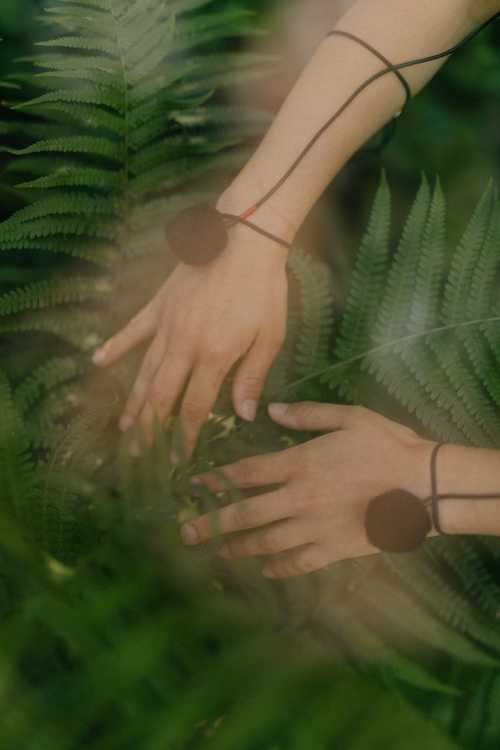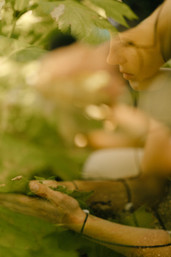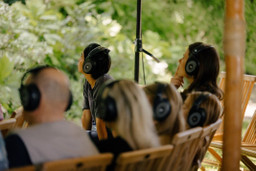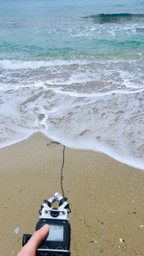
On solastalgia, sound as eco-social testimony, and more: An interview with Mélia Roger
Mélia Roger is a French field recordist working on the sidelines of the sound arts and cinema industry. She creates installations which feature voice and field recordings. She enjoys spending time outside, recording both animate and inanimate sources of sound, and using her practice as a way of thinking and being in the world.
Mélia was recently a guest on the Wind Is the New Radio podcast, which is produced by earth.fm. Her conversation with presenter Melissa Pons touched upon many topics, ranging from Mélia’s significant experience in recording, animal tracking, the concept of ‘solastalgia’, deep listening, her art installations, and her influences, including literature and films that have changed her perspective or added meaning to her practice.
The following material has been edited for clarity. For the full interview – which includes details about Mélia’s residency around resilience in Serrinha do Alambari, Brazil, and the reality of recording as a woman alone in the field – please listen to the full episode (coming soon!).
What is your most significant memory that relates to your fascination with natural sounds?
I grew up in the city, but I had grandparents that were taking me out every weekend in the French countryside. And I think one of my oldest memories of what we call nature was a fascination for horses and their breath, and being so close to them and feeling empathy and connection with them. When I was a kid one of the horses died; this was my first grief. This was the first connection I had with what we call the wild, even though they were not wild horses.
I think being present and listening is a source of meditation. I don’t feel the need to put the word to it, but it’s really part of my way of living and being happy.
In terms of sounds, when you are a kid and you learn to imitate the owl, and looking at my dad making these calls for the owl to answer and thinking if the owls would answer or not. And I had dreams where an owl would come very close to us and sit on the table.
How do you approach animals or the natural world?
Recently, I’ve been trying to gain knowledge in animal tracking, taking workshops about learning to identify different traces that you find in the bush. For me, this is completely new, and I feel there is so much to learn, it’s like the door to understanding and entering into dialogue with other beings. And I’m just at the beginning of it because when you enter ethology [the science of animal behavior] or ornithology, there are so many things to discover, to learn, and you can go very deep in a scientific way, into names and behavior.

It has also changed the way I was behaving in the field, the places I was choosing for placing my microphones or working with my partner, Grégoire. We do this a lot together and we both see that [this knowledge] is changing so much [about what we see in the landscape]. It’s a new way of reading a path or reading a landscape, basically, and is very much inspired by books by [Belgian philosopher of science] Vinciane Despret [and French writer and lecturer on philosophy] Baptiste Morizot, like all those environmental philosophies that are more and more popular nowadays.
Has sound, or something connected to it, changed your assumptions and worldview?
I think the practice of having microphones in the hand and relating to the world through them changed the way I was perceiving other beings, for sure. Suddenly it was as if I was discovering the intimacy of plants, or fungi, or roots, or leaves. And it was very raw and very concrete because it was still through my own perspective.
I was really influenced by sonic massages when I studied for the Master of Transdisciplinary Studies in Zürich. You just collect different things. It can be anything, it can be your credit card making a nice sound and then you perform it for someone, using sound as a way of massaging the ears.
In my practice, I wasn’t trying to enter the worlds of plants, for example, through sonification [the use of non-speech audio to convey information] or using DNA for creating music or using other data from biology and transforming them into sounds. The idea was to keep the human perspective but to fill the invisible gap that exists between all of us. This was linked to two philosophies or concept questions; I was going to reading groups about new materialism and thinking about ways of connecting more fluidly between beings. All of those gestures were completely influenced by those concepts. And I think this had somehow an unconscious resonance of my perception of sounds as a moving volume, not as a strict scientific way of thinking – like, sound waves are dilations and atoms transmitting a wave – but as something fluid, like a fog. And when you start to become a liquid body, you become an octopus somehow. And the hands are in contact with others.
There was a drawing in my notebook of water spiders that can move around [on the surface of water]. And I drew their patterns on water, and I was wondering why they don’t sink? What is the connection between their legs and the surface? And this is [like] the point of connection with the microphone and the hand. For me, this was really beautiful as an image, and I tried to also use it as a concept for thinking.
In Staying with the Trouble, Donna Haraway refers to the tool of sin, an alternative to the concepts of the Anthropocene and the Capitalocene, which blurs boundaries between species, and therefore disrupts our hierarchical understanding of a white Western male-dominated planet. And I really want my microphones to be actors of this trouble, offering a new position to listen to our world in a conscious way.
I also got very much into the texts (like the ones of Karen Barad) about this touching and not touching duality; like in quantum theory, when two hands are touching, they repulse each other and the atoms never really touch; they are always going away from each other. They are repelling, never touching.
When you touch your own hands, you touch the alterity within; you are making contact with the otherness inside you. I used this in a film that I made in France, slightly touching the rug on which I was laying and touching my own hands as well, and thinking of the microphone and empathic listening as a way to connect to the otherness which is inside oneself.

Does your practice include some sort of meditative or spiritual level?
In my everyday life, I don’t do meditation, but it’s something that I’ve been connected to since always because my parents both worked with sophrology and relaxation. And I used those techniques to fall asleep, to concentrate on breathing and being connected to emotions, etc. So it’s something that I can relate to, but I don’t consciously connect to it through my practice.
I think being present and listening is a source of meditation. I don’t feel the need to put the word to it, but it’s really part of my way of living and being happy. When I’m out there, listening – it doesn’t have to be through microphones, it can be just with my ears – I feel completely full. I’m just here and that’s it. And there is nothing else and I love it. It’s awesome.
Can sound be a testimonial for eco-social conflicts?
This is the hardest question. Actually, I was thinking a lot about your album [Melissa’s Wolf Soundscapes], because certain entities like wolves can be a matter of conflict or of different sides coming together: the sheep, the shepherd, the wolves, nature preservation. There are so many actors in this constellation; for me, your work is a really good entrance to interrogate those relations.
For now, in my practice, I don’t have any work directly addressing a conflict or a social situation. In some recordings there are conflicts, like when you think of sonic encounters, of biophony and anthropophony, like when you are recording a bird and there is a huge motor on the side, when you have this overlapping of worlds that were not supposed to meet.
And it then becomes a political decision: which sounds are you keeping? Am I making a whole album with only “nature” sounds and I’m taking away all the planes? Idealizing nature, which actually doesn’t exist anymore. There are so many places where we go to record where you also have planes and it’s really hard to conceal those questions.
But if I think of a poetical and political approach, I would think of the word solastalgia [emotional or existential distress caused by environmental change]. It’s a concept from an Australian philosopher called Glenn Alberecht, and it’s a word that conceals this nostalgia of home. Meaning that, especially because of the climate crisis, you might have known your home in a completely different way, and now it’s changing, disappearing: seas are rising, fires burned the forests and you didn’t move from your home and somehow you feel in exile. I hate that this word exists, but it’s a really nice concept to dive into the intimate relation that we have with the landscape, and how the crisis and the destruction of our planet is completely transforming those places.

What can we make as artists and sound recordists [in response]? How can we show what is happening? We hear it all the time in our recordings, it’s obvious that there are less birds, less insects, and noise pollution is everywhere. This [the climate crisis] is a sonic phenomenon also. How can we then make the link between what is happening and the public? And how can we create emotions and stories that mean people feel inspired to change something or to vote for the right person or to eat less meat or to not take planes anymore? How can these emotions be translated into concrete actions?
Solastalgia is a nice entrance to this link between environment and individual emotional connection to it. And for the French-speaking listeners of this podcast, there is a podcast that I was doing with Nouvelles Écoutes called Solastalgie, where we went to six different places to record stories of people who had had their environment changed. I did this with Flora Trouilloud, a journalist working with environmental questions. Her approach is really important nowadays: to find ways to connect personal stories to bigger environmental crises.
Chris Watson was working on similar projects in the UK, with the studio Invisible Flock: Land Body Ecologies Podcast, a series also addressing the solastalgia concept and finding stories of people who are living it. I think it’s a nice road to create awareness or inspire the general public, because it’s really hard to have empathy toward a bee; you have to create a story that generates empathy.
Featured photo by Johannes Berger – Sonic Topologies festival (2022)
All photos courtesy of Mélia Roger
Earth.fm is a completely free streaming service of 1000+ nature sounds from around the world, offering natural soundscapes and guided meditations for people who wish to listen to nature, relax, and become more connected. Launched in 2022, Earth.fm is a non-profit and a 1% for the Planet Environmental Partner.
Check out our recordings of nature ambience from sound recordists and artists spanning the globe, our thematic playlists of immersive soundscapes and our Wind Is the Original Radio podcast.
You can join the Earth.fm family by signing up for our newsletter of weekly inspiration for your precious ears, or become a member to enjoy the extra Earth.fm features and goodies and support us on our mission.
Subscription fees contribute to growing our library of authentic nature sounds, research into topics like noise pollution and the connection between nature and mental wellbeing, as well as funding grants that support emerging nature sound recordists from underprivileged communities.
